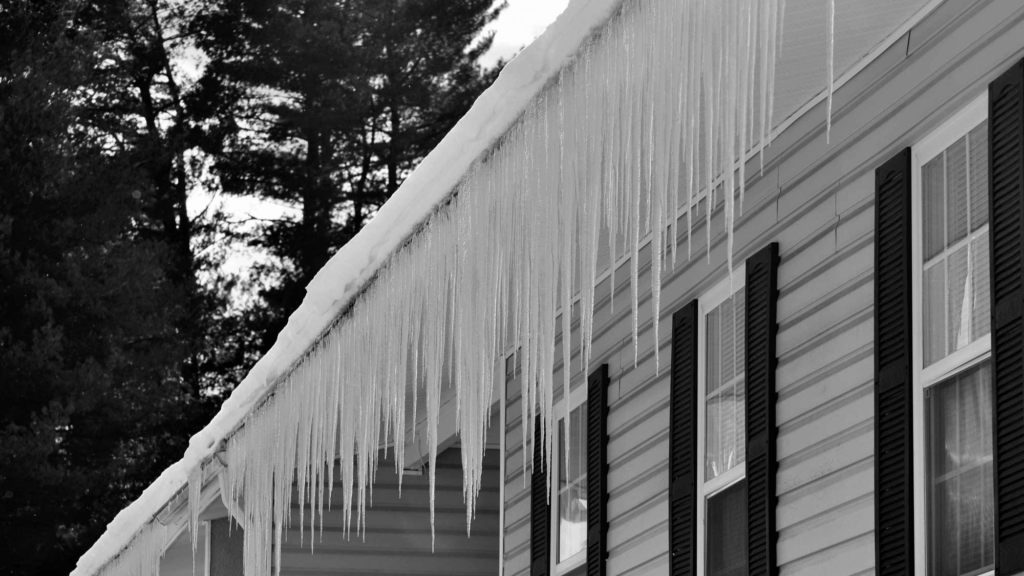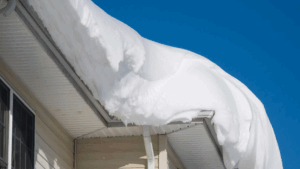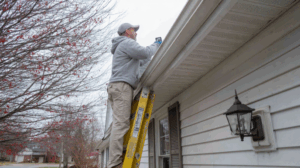If you’ve been through a winter in Dayton, you know what I’m talking about: ice‑coated eaves one minute, saturated ceilings the next. That’s when real homeowners stop and ask: can ice dams cause roof damage? or how do ice dams damage roofs?
At Cornett Roofing Systems, we’ve seen it all—ice that builds slowly at a roof’s edge, water creeping under shingles, winter damage that could have been avoided with a little prep. That’s why I want to walk you through actionable, real‑world ice damage prevention tips so your roof stays dry, your insulation stays intact, and you head into winter confident.
What You’ll Find in This Guide
- Why ice dam risk is very real in Dayton’s winter climate
- Critical things to inspect now before snow arrives
- A step‑by‑step plan to stop ice dam roof damage in its tracks
- Materials, risks, warranties—what to know and what to do
- Answers to the most common homeowner questions about winter roof damage
Looking for year-round maintenance advice beyond winter prep? Don’t miss our Year-Round Roof Maintenance Guide for Indianapolis Homeowners—perfect for staying ahead of seasonal wear in any weather.

Why Ice Dam Roof Damage Hits Dayton Homes
We don’t always think much about it until we’re standing in a puddle on the attic floor—but ice dam roof damage is no myth. Here’s why it matters in Dayton:
An ice dam forms when your attic is too warm, snow melts on the roof deck, then runs down and refreezes at the eaves. That ice wall stops proper drainage and forces the melt‑water back under shingles. That’s how roof ice damage really starts.
Dayton’s winter climate—a mix of snowfall, thaw, refreeze cycles—makes conditions perfect for those problems. Combine that with old insulation, blocked vents, clogged gutters or shallow roof eaves, and you’ve got a recipe for trouble. So yes, ice dams absolutely can cause roof damage—and we’re going to show you how to stop it.
Prep Before the First Snow: Get Your Roof Ready
Budgeting & Scheduling
The best time to act? Before the first heavy snowfall. Penny‑wise now means less cost and stress later. Plan for attic inspection, gutter service, and possible upgrades.
Tools, Materials, & Safety
You’ll want a reliable ladder, gloves, safety gear, and possibly professional gear if your home is multi‑story or the roof is steep. If you don’t feel safe, call the pros.
Code & Insulation Check
Some newer building codes require ice‑water membranes or improved venting. Even if your house is older, getting ahead of it can save you headaches—and money.
How to Prevent Ice Dam Roof Damage Step by Step
Optimize Attic Insulation & Ventilation
Heat escaping through the attic roof deck melts the snow above. Seal gaps, check insulation, ensure vents are not blocked. That’s one of the biggest moves you can make.
Clear Gutters and Confirm Drainage
Blockages mean water sits, freezes at the eaves, and creates that dangerous ice buildup. Sweep the gutters, flush the downspouts—and make sure they kick water away from your foundation.
Protect the Roof Edge & Manage Snow Load
If your roof lacks an ice‑water barrier under shingles at the edge, you’re exposed. Also, after snow accumulates, remove excess buildup from roof edges safely to reduce ice‑dam risk.
Monitor Warning Signs
Keep an eye out for long icicles, uneven snow melt patterns, frost inside your attic, or surface stains. When those appear, they’re your cue to act—not wait.
Deep Dive: Roofing Systems, Materials & Long‑Term Strategy
How Different Roofs Handle Ice
- Asphalt shingles: Most common. Works fine—if the attic is insulated and ventilated. If not, expect faster wear.
- Metal roofs: Great for shedding snow, good ice resistance—but only if installed correctly with right underlay and ventilation.
- Slate or tile: Premium option with longevity—but heavy, costly, and needs strong structure and expert installation.
Local Risk Factors in Dayton
Older homes often have minimal insulation, multiple roof features (dormers, valleys) that trap snow, and heavy limbs from surrounding trees adding debris to gutters. These factors boost your risk of ice‑dam creation and roof damage.
Warranty & Maintenance Link
Many roofing warranties assume you’re performing maintenance: cleaning gutters, checking ventilation, keeping attic dry. If you skip those, you’re exposing your home to roof ice damage and potentially voiding your coverage. At Cornett Roofing Systems, we not only inspect—we document, support, and maintain your system for the long haul.
| Material | Pros | Watch This |
| Asphalt | Affordable, widely used | Vulnerable if attic/ventilation is poor |
| Metal | Long life, snow sheds well | Requires precision install |
| Slate/Tile | Highest durability | High cost, specialized install needed |

Common Winter Roof Damage Questions from Dayton Homeowners
As roofing professionals who work across Dayton and the surrounding communities, we hear a lot of the same questions this time of year. Here’s what local homeowners are asking about ice dams and winter roof issues—and what you need to know before snow starts falling.
How do ice dams actually form on my roof?
Ice dams form when heat from your attic melts the snow on your roof. That water then runs down to the colder roof edge and refreezes, forming a ridge that traps more meltwater behind it.
Can roof ice damage happen even if my roof is fairly new?
Yes, roof ice damage can still happen on newer roofs if attic ventilation or insulation isn’t properly balanced. A well-installed roof still needs a complete system to manage winter conditions effectively.
What’s the fastest way to tell if my home is at risk?
The fastest way to tell if your home is at risk for ice dam damage is to look for uneven snow melt, large icicles near gutters, or moisture in the attic. These signs suggest heat loss and poor drainage—two major ice dam triggers.
Will heat cables on the roof stop ice dams?
Heat cables can help prevent ice dams in problem areas, but they’re not a full solution. They work best when combined with improved attic insulation, proper ventilation, and clean gutters.
Do I need professional help to prevent ice damage?
You don’t always need a professional, but a licensed roofing contractor can spot issues the average homeowner might miss—especially in hard-to-reach roof areas or with hidden ventilation problems.
Get Ahead of Ice-Related Roof Damage
In Dayton, winter isn’t gentle—it tests every part of your roof system. But you don’t have to wait for damage. With smart preparation, proper materials, and professional support, you can beat ice dam roof damage before it hits.
At Cornett Roofing Systems, we’ve spent over 30 years helping homeowners safeguard their roofs—and their homes—through cold weather conditions. From inspection to preventive upgrades, we’ve got your back.
Schedule your free inspection today.





